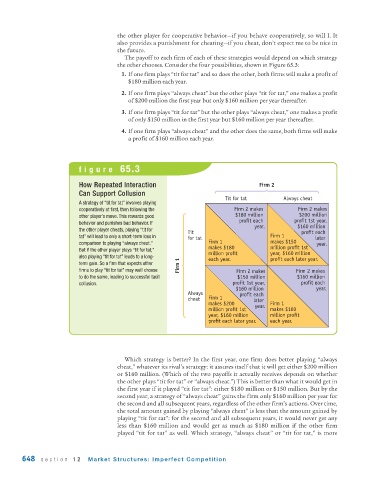Page 690 - Krugmans Economics for AP Text Book_Neat
P. 690
the other player for cooperative behavior—if you behave cooperatively, so will I. It
also provides a punishment for cheating—if you cheat, don’t expect me to be nice in
the future.
The payoff to each firm of each of these strategies would depend on which strategy
the other chooses. Consider the four possibilities, shown in Figure 65.3:
1. If one firm plays “tit for tat” and so does the other, both firms will make a profit of
$180 million each year.
2. If one firm plays “always cheat” but the other plays “tit for tat,” one makes a profit
of $200 million the first year but only $160 million per year thereafter.
3. If one firm plays “tit for tat” but the other plays “always cheat,” one makes a profit
of only $150 million in the first year but $160 million per year thereafter.
4. If one firm plays “always cheat” and the other does the same, both firms will make
a profit of $160 million each year.
figure 65.3
How Repeated Interaction Firm 2
Can Support Collusion
Tit for tat Always cheat
A strategy of “tit for tat” involves playing
cooperatively at first, then following the Firm 2 makes Firm 2 makes
other player’s move. This rewards good $180 million $200 million
profit each profit 1st year,
behavior and punishes bad behavior. If
year. $160 million
the other player cheats, playing “tit for
Tit profit each
tat” will lead to only a short-term loss in for tat Firm 1 later
comparison to playing “always cheat.” Firm 1 makes $150 year.
makes $180 million profit 1st
But if the other player plays “tit for tat,”
million profit year, $160 million
also playing “tit for tat” leads to a long- each year. profit each later year.
term gain. So a firm that expects other Firm 1
firms to play “tit for tat” may well choose Firm 2 makes Firm 2 makes
to do the same, leading to successful tacit $150 million $160 million
collusion. profit 1st year, profit each
$160 million year.
Always profit each
cheat Firm 1 later
makes $200 year. Firm 1
million profit 1st makes $160
year, $160 million million profit
profit each later year. each year.
Which strategy is better? In the first year, one firm does better playing “always
cheat,” whatever its rival’s strategy: it assures itself that it will get either $200 million
or $160 million. (Which of the two payoffs it actually receives depends on whether
the other plays “tit for tat” or “always cheat.”) This is better than what it would get in
the first year if it played “tit for tat”: either $180 million or $150 million. But by the
second year, a strategy of “always cheat” gains the firm only $160 million per year for
the second and all subsequent years, regardless of the other firm’s actions. Over time,
the total amount gained by playing “always cheat” is less than the amount gained by
playing “tit for tat”: for the second and all subsequent years, it would never get any
less than $160 million and would get as much as $180 million if the other firm
played “tit for tat” as well. Which strategy, “always cheat” or “tit for tat,” is more
648 section 12 Market Structures: Imperfect Competition

